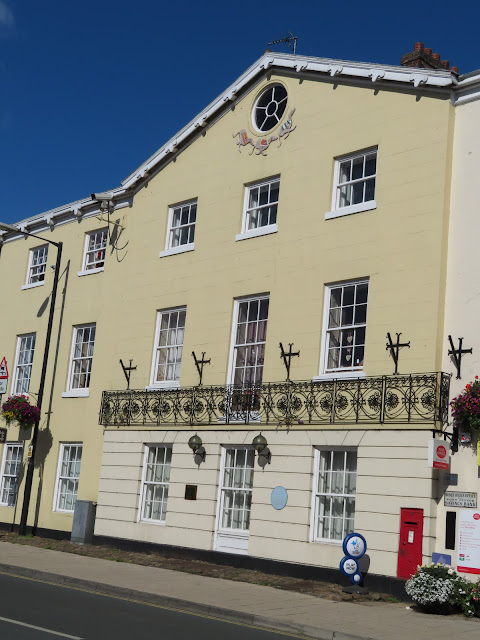We had only been to Boroughbridge once before as we passed on a trip down the A1 at some time in the past. We therefore were looking forward to having a good look around the place.
We left the moorings that are near a round-about through which the canal goes through the middle. The roads are bridges over the canal. Boroughbridge bridge was the scene of a battle in 1322 when a rebellion against the useless King Edward II. The Duke of Lancaster eventually rebelled against him, along with others. However he was also incompetent and several Lords sided with the King still. There was a battle near Burton on Trent that Lancaster lost and started his retreat to his homelands in the north. Sir Andrew Harcla, Governor of Carslise went to cut him off and blocked the wooden bridge at Boroughbridge. The ford at Milby, where the lock is now, was also manned. Lancaster's men and knights were defeated and retreated into the town. Lancaster claimed sanctuary in the church but was dragged out and was later beheaded.
Just about the first building you come to after crossing the river bridge is this solicitors office with the painted pargetting. I love the windows too, and it shows that there was money in the town at sometime at least.
Boroughbridge is strategicaly placed almost exactly half way between Edinburgh and London and was on the drovers route to bring the cattle form Scotland to the south. At the busiest time over 2000 head of cattle a day were passing through the town. Consequently there were 22 inns in the town. This was the three Greyhounds but is a private flats now.
These houses were actually built as fisherman's cottages on the Market Square. They caught fish in the RiverTut that joins the Ure just near the bridge. In the square is also the local Tourist Information Office and they have lots of local walks and information.
Across the square is the old Butter Market that was built to protect the local ladies that sold their produce here. It is now an outdoor museum showing industrial, domestic and farming artefacts from the area.
In St. James Square is the well. This was the position of the church where the Duke of Lancaster took sanctuary but was dragged out once stood. This structure was built over an artesian well by the friends of Andrew Sherlock Lawson of Aldborough Manor in 1875 after his death in 1872. It was the main source of water for the town.
The pump was added by Mrs Lawson of Aldborough Manor in the same year
This is the River Tut where the fishermen made their living and eels were caught. As we passed a kingfisher just flew away form a perch just below the parapet of the bridge.
To the west of the town are the Devil's Arrows. This one is by the side of the road and is the biggest at 6.9 mt tall, bigger than anything at Stonehenge. The fluting is caused by natural weathering rather than man made. Across the road are two other standing stones.
There is a large gap between the tallest and the next in line, to the left. It is thought that there is a missing one, and it is said that it had been taken out to search for treasure below it and was then incorporated in the bridge over the River Tut seen above.
There are several old enameled signs around the town, along with butchers and delis that force you to buy pies and cakes!!
We wandered up the road to Aldborough. In the background the white building is Aldborough Manor and is now the HQ for the Northern Aldborough Festival that was started in 1994 to raise money for the Church organ and has gone from strength to strength over the years staging musical events. In the front is the Battle Cross that was erected in Boroughbridge soon after the victory at the bridge. It was moved here in 1852.
On the village green is the village maypole that is used every year. In the background can be seen St. Andrew's Church. It is the third on the site and housed the organ that needed repair that led to the starting of the Festival.
With Boroughbridge's transient population it became the site of a horsefair for 14 days in June. Gypsies, drovers and horse traders congregated in the street and much money changed hands all over the town. In the street Horsefair can be seen this cast iron circle that was found outside a forge where the wheels would be repaired for the all the carts and the stage coaches that used the Great North Road. The relief of the town must have been great when the town was bypassed by the building of the A1 to the west.
Boroughbridge an area seem a lovely spot with plenty of walks to be had, big houses to visit and much else besides. I think we will come back again sometime.














No comments:
Post a Comment